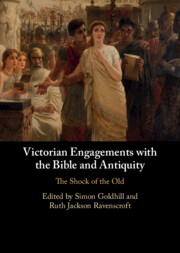Book contents
- Victorian Engagements with the Bible and Antiquity
- Victorian Engagements with the Bible and Antiquity
- Copyright page
- Contents
- Figures
- Contributors
- Acknowledgements
- 1 Introduction
- Part I Antiquity’s Modernity
- Part II Making the Past Visible
- 4 The Bible, Classical Antiquity, and the Invention of Victorian Art at the 1887 Manchester Jubilee Exhibition
- 5 The Classical and Biblical in Dialogue
- Part III Materiality and Spectacle
- Part IV Travelling the World
- Part V Manuscripts, Morality, and Metaphysics
- Part VI Intellectual Superstars
- Bibliography
- Index
4 - The Bible, Classical Antiquity, and the Invention of Victorian Art at the 1887 Manchester Jubilee Exhibition
from Part II - Making the Past Visible
Published online by Cambridge University Press: 28 September 2023
- Victorian Engagements with the Bible and Antiquity
- Victorian Engagements with the Bible and Antiquity
- Copyright page
- Contents
- Figures
- Contributors
- Acknowledgements
- 1 Introduction
- Part I Antiquity’s Modernity
- Part II Making the Past Visible
- 4 The Bible, Classical Antiquity, and the Invention of Victorian Art at the 1887 Manchester Jubilee Exhibition
- 5 The Classical and Biblical in Dialogue
- Part III Materiality and Spectacle
- Part IV Travelling the World
- Part V Manuscripts, Morality, and Metaphysics
- Part VI Intellectual Superstars
- Bibliography
- Index
Summary
The Fine Arts Department of the Manchester Jubilee Exhibition of 1887 set out to provide a comprehensive exhibition of art made in Britain during Queen Victoria’s reign. This was the first ever exhibition of ‘Victorian art’; it marks a significant moment in the formation of a national ‘school’ of art in Britain, and in the presentation of this national story to a mass audience. The exhibition was avowedly commercial, concerned with progress and manufacture. Yet it was images of the past – and the biblical and classical pasts in particular – which dominated the Central Hall of the Fine Arts Department in this apparently ‘modern’ display. These pasts also appeared prominently throughout the rest of the Fine Arts Department. This chapter explores the relationships between the Bible, classical antiquity, and the mass audiences for art who thronged to look at the nineteenth-century oil painting and sculpture on display at Manchester. What role did the Bible and antiquity play in the invention of Victorian art at the Manchester Jubilee Exhibition? And what can responses to the exhibition at Manchester tell us about Victorian understandings of biblical and classical works?
Keywords
- Type
- Chapter
- Information
- Victorian Engagements with the Bible and AntiquityThe Shock of the Old, pp. 83 - 121Publisher: Cambridge University PressPrint publication year: 2023



